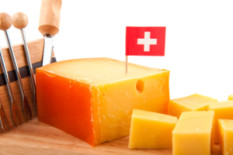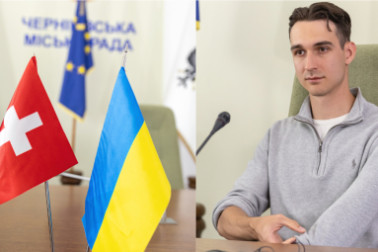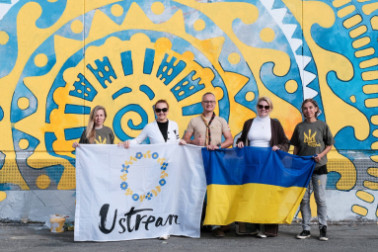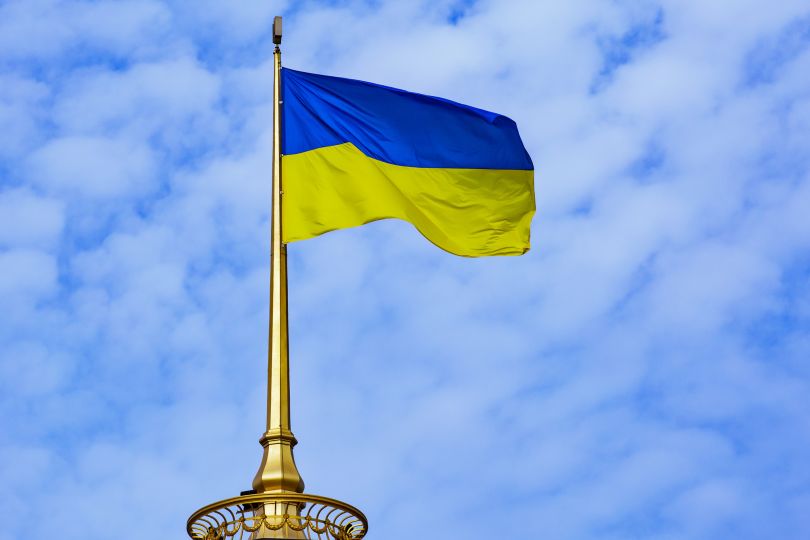
Interesting Facts about the Flag of Ukraine:
It is recognized worldwide and proudly displayed in various countries as a symbol of support for Ukrainians and, very often, as a symbol of freedom. What is the history behind the Ukrainian flag, and what does it symbolize?
The meanings of the blue and yellow colors on the flag are interpreted differently. One popular explanation is that the yellow (or gold) symbolizes God the Father, the Creator, and the Higher Spirituality. Blue represents everything earthly and freedom of choice, with the hope that people will not abuse it. However, the most common interpretation is the well-known combination of pure blue sky stretching over the yellow wheat field, symbolizing peaceful work and prosperity.
The first historical mention of the blue and yellow combination was recorded in 1256, on the day Lviv was founded. King Danylo, who named the city after his son Lev (meaning lion), presented the city with a coat of arms. It featured a golden lion on a blue background, which remains a symbol of Lviv to this day.
The color scheme of the flag has existed for over a thousand years. It is associated with the Great Migration of Peoples around 3000 BCE. This natural combination is particularly fitting for the granary of Europe, which Ukraine has been referred to for many years.
The first attempt to create a yellow-blue flag in the format we are familiar with today (blue and yellow, with two horizontal stripes) was made by the Main Rus Council, an organization representing the national movement of the Ukrainian community in Galicia. During the revolutionary "Spring of Nations" in 1848, this council revived the use of the coat of arms featuring the aforementioned golden lion in Lviv. The flag, with the combination of blue and yellow colors, practically the same as we see it today, became the national flag.
At the beginning of the 20th century, the blue and yellow flag became popular (with the upper stripe yellow). It was influenced by the widespread practice in Germany of creating local flags where the color of the upper stripe represents the main heraldic figure. Until the beginning of 1918, both flag color combinations were used.
After the February Revolution of 1917, blue and yellow flags appeared in various Ukrainian cities, including Kyiv, Odesa, and Kharkiv. The first official recognition of the blue and yellow banner as a national symbol occurred on March 22, 1918. The Central Rada adopted a law approving the combination of blue and yellow colors on the Ukrainian People's Republic (UNR) flag. In 1938-1939, the blue and yellow flag was used as the flag of Carpathian Ukraine, and in 1941, it became the flag of the self-proclaimed Ukrainian State in Lviv.
During the Soviet occupation, possessing a blue and yellow flag was considered a serious crime, and its display in public was seen as an extraordinary event. Interestingly, the first flag of the so-called Ukrainian People's Republic of Soviets (a Bolshevik puppet entity from 1917-1919) featured a red flag with a blue and yellow flag in the upper left corner. However, due to suppressing the national consciousness of Ukrainians, it was removed in 1919 and replaced with the letters USRR.
The affirmation of Ukraine's independence began with the raising blue and yellow flags in different parts of the country. On April 26, 1989, a memorial meeting for the victims of the Chornobyl tragedy took place under the well-known Ukrainian flag. The national flag was also raised on May 22 of the same year at the closure of the Shevchenko festival. On March 23 of the following year, it appeared above the Lviv City Council. On July 24, the blue and yellow flag, blessed in St. Sophia's Cathedral by the bishops of the UOC and UGCC, was solemnly raised above the building of the Kyiv City Council.
On September 18, 1991, the Presidium of the Verkhovna Rada of Ukraine granted the blue and yellow flag the status of the country's official symbol. On January 28, 1992, the Verkhovna Rada adopted a resolution "On the Approval of the National Flag of Ukraine as the State Flag of Ukraine."
In June 2014, the largest Ukrainian flag was painted in Kyiv. Thousands of volunteers painted a large section of a concrete slope on the Obolon embankment in blue and yellow colors.
In 2016, on the occasion of the 25th anniversary of Independence, blue and yellow flowers were planted in the Museum of Architecture and Life in Pyrohiv, forming a giant Ukrainian flag. It entered the Ukrainian Book of Records as the largest floral carpet.
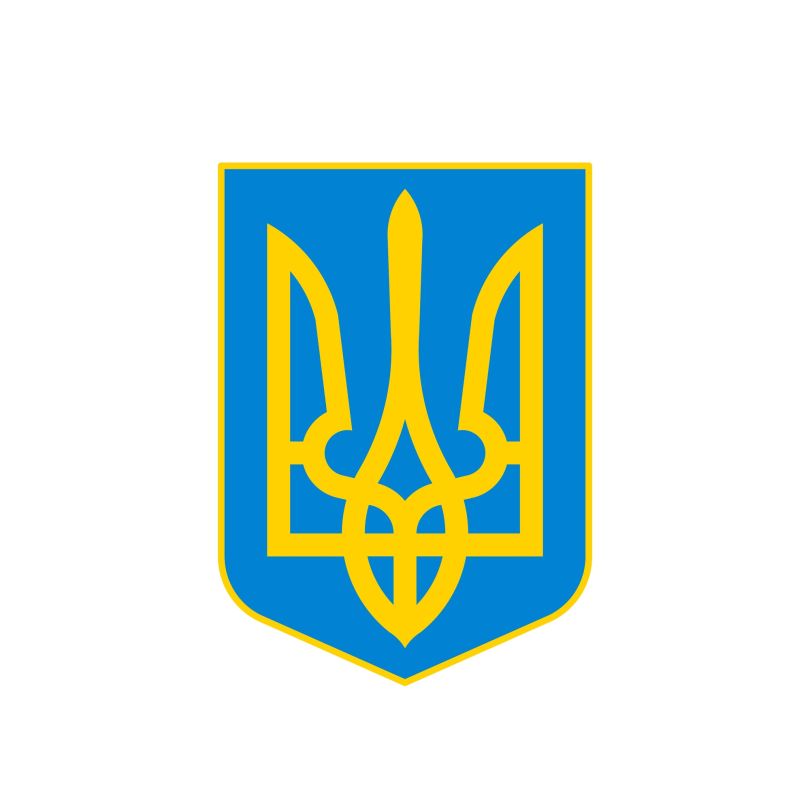
Interesting Facts about the Coat of Arms of Ukraine
The Ukrainian Coat of arms also has a long history dating back to the times of Rus.
The trident was used as a talisman in ancient times. Its images have been preserved on many cultural artifacts dating back to the 1st century. It is also known that this symbol was an element of the symbolism of other nations. A similar symbol was used for Neptune.
The exact interpretation of the trident is still unknown. At the moment, there are about 40 different versions of its origin. Those who adhere to religious interpretations, in particular, argue that the trident means "Trisagion" - a schematic depiction of a dove as a symbol of the Holy Spirit. A popular hypothesis is that the trident represents a falcon diving for prey. An interesting coincidence is that in the Ukrainian trident, as it is depicted now, one can see the word "VOLYA" (meaning "freedom") - something that Ukrainians aspire to.
Historians have long debated whether the trident was exclusively a symbol of the Rurik dynasty princes or an ancient Slavic symbol. In any case, during the times of Kyivan Rus, the trident was carved on the coins of the princes, molded from clay and brick, and depicted on pottery. However, this trend declined from the 11th century onwards, as only three princes of Rus used the trident as their symbol. In the mid-13th century, the Rurik dynasty symbols disappeared from use. The trident was almost forgotten for nearly 700 years.
The Galicia-Volhynia state, the direct successor of Kyivan Rus, used a coat of arms depicting the Ruthenian lion - a golden lion on a blue/azure background. The Ruthenian lion first appeared on the seal of Ruthenian king Yuri I Lvovych, dating back to the early 14th century. The Ruthenian lion was used as a state symbol of Rus and was minted on Ruthenian coins. After the collapse of the Galicia-Volhynia state, the Ruthenian lion continued to be used as a coat of arms but on a regional level.
During the time of the Zaporozhian Host, the first original Ukrainian Coat of arms emerged - the Knight with a Trident or the Cossack with a Musket. The Coat of arms did not have fixed colors, so several variations existed. In the 18th century, on the regimental and sotnia (company) flags of the Hetmanate, the Cossack was depicted in a red or gilded coat on a blue or gold background.
After the Ukrainian National Republic (UNR) proclaimed independence, there was a prolonged debate among the elite circles about which historical symbol was worthy of becoming the Coat of Arms - the symbol of modern Ukrainian statehood. Initially, three contenders were considered: the Galician Golden Lion, which was seen as a symbol of the western regions of Ukraine; the Kyivan archistrategos Michael, who in the late 19th and early 20th centuries began to be perceived as the Coat of arms of the Dnieper Ukraine; and the Knight with a Trident, which was already interpreted as a "national coat of arms" in the 18th century. In the fall of 1917, Mykhailo Hrushevsky even proposed creating a new symbol of "creative peaceful work in the new Ukraine" - a golden plow on a blue background.
The mysterious trident symbol, which was on the coins of Prince Volodymyr the Great but was known only to a narrow circle of experts at the time, was initially seen as a compromise option. However, it turned out to be the best fit for the role of a national symbol. Long forgotten but rediscovered, the trident quickly began to be perceived as Ukraine's national Coat of arms.
Unlike the UNR, the West Ukrainian National Republic (ZUNR) approved the Ruthenian lion as its Coat of arms. However, on January 22, 1919, after the Act of Union, it was replaced by the trident on the territories of Galicia, thus permanently stepping into the background.
During the Soviet occupation, the trident began to be persecuted because of its significance for Ukrainian culture and love for freedom, which Moscow sought to destroy. The Coat of arms began to be considered a "symbol of Ukrainian nationalists." It was only during Ukrainian independence that the trident finally emerged from the underground and firmly established itself as the State Coat of Arms of Ukraine.
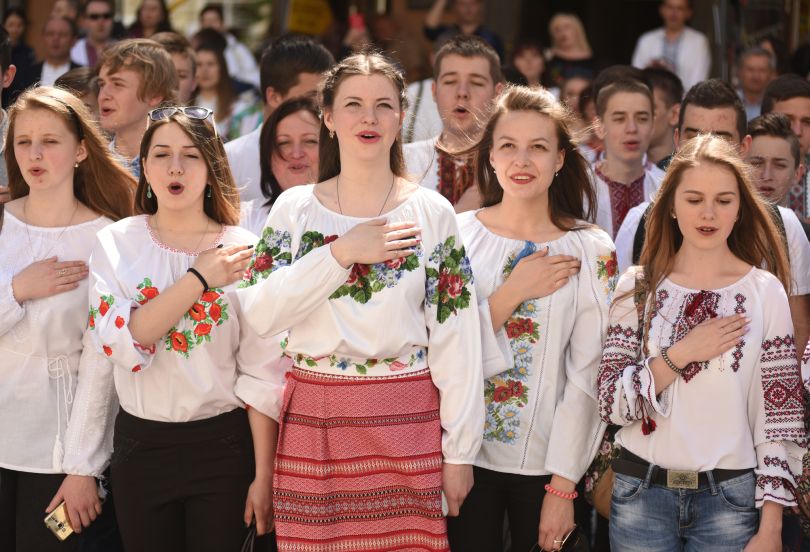
Interesting facts about the anthem of Ukraine
The Ukrainian anthem is not only a national symbol but also a symbol of freedom, resilience, and belief in victory.
Pavlo Chubynsky wrote "Shche ne vmerla Ukraina" (Ukraine has not yet died) in half an hour. According to eyewitness accounts, in the autumn of 1862, at one of Chubynsky's gatherings, Serbian students studying at Kyiv University sang a patriotic song that mentioned Tsar Dušan, and in the refrain were the words "srce bje I krv lijе za svoju slobodu" (or "srb se bije I krv lijе za svoju slobodu..."). This song greatly inspired Chubynsky, who suddenly went to another room and returned in half an hour with the completed lyrics of the song "Shche ne very Ukraina."
The first performance of a composition by composer Mykhailo Verbytsky with lyrics by poet Pavlo Chubynsky took place on March 10, 1865, at the Shevchenko's memorial in the city of Przemyśl, which is now in Poland. It became very popular because it effectively conveyed the thoughts and emotions of Ukrainians, and thus, its establishment as the anthem of Ukraine was only a matter of time.
Initially, Verbytsky composed the music for the guitar, as the piece was originally intended to be performed as a solo. He later adapted it for choral singing.
The new composition quickly spread among pro-Ukrainian circles. Due to the "harmful influence on the minds of common people," Pavlo Chubynsky was sent to live under police supervision in the Arkhangelsk Governorate. He was only able to return after seven years.
During the time of the Ukrainian People's Republic (UNR), "Shche ne very Ukraina" was the national anthem, but it did not have official status as a musical composition. It was first recognized as the national anthem by the Seym of the Carpathian Ukraine at its first and last session on March 15, 1939.
During the Soviet occupation, the song was not adopted as the anthem of the Ukrainian SSR because its lyrics "contradicted communist ideology." The composition was banned as "bourgeois-nationalistic." However, despite this, it was published in Kuban (an ethnic territory of Ukraine now part of the Russian Federation) in a collection of Kuban folk songs disguised as folk songs.
On March 6, 2003, the Verkhovna Rada (Ukrainian parliament) adopted the Law of Ukraine, "On the State Anthem of Ukraine." The composition "Shche ne very Ukraina," with slightly modified lyrics by Pavlo Chubynsky and music by Mykhailo Verbytsky, officially became the State Anthem. It is now sung by adults and children in Ukraine far beyond its borders.
All three national symbols of Ukraine have become trendy. The color combination in clothing, jewelry in the form of the trident, and ringtones on phones - Ukrainian symbolism has long transcended official events and become part of the everyday life of Ukrainians and even our friends abroad.

